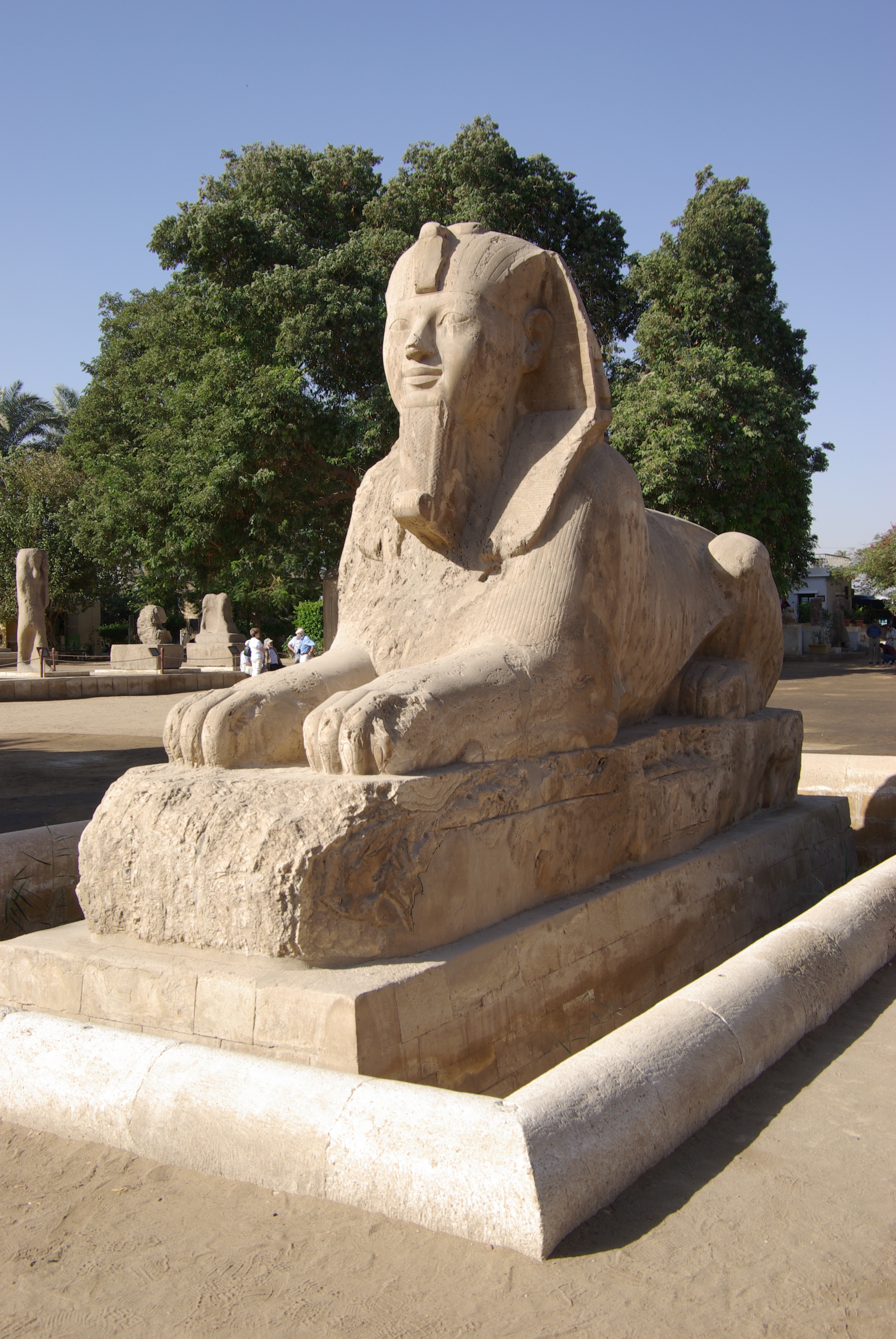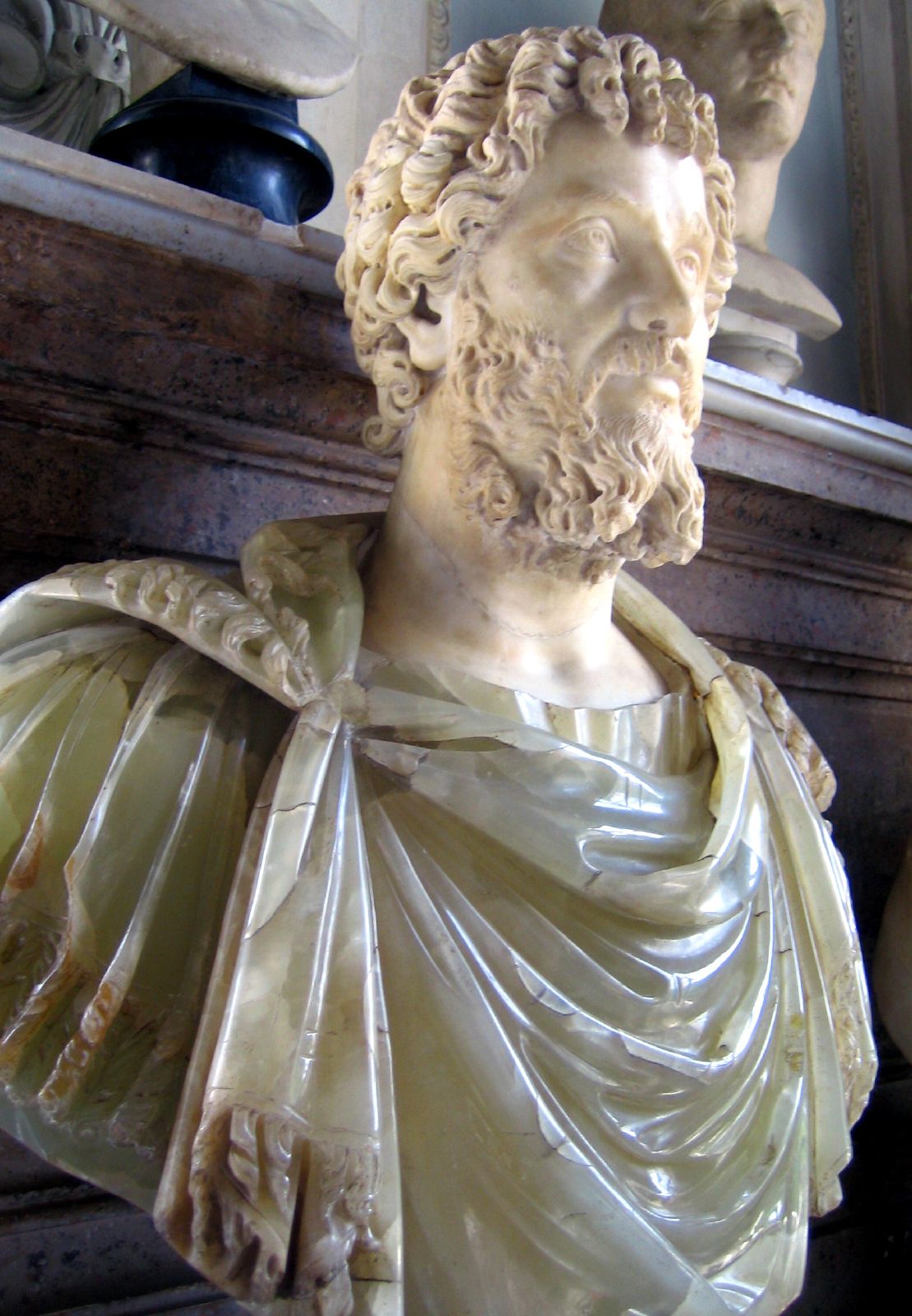|
Sphinx Of Memphis
The Sphinx of Memphis is a stone sphinx located near the remains of Memphis, Egypt. The carving was believed to take place between 1700 and 1400 BCE, which was during the 18th Dynasty. It is unknown which pharaoh is being honored and there are no inscriptions to supply information. The facial features imply that the Sphinx is honoring Hatshepsut, or Amenhotep II, or Amenhotep III. Discovery The Alabaster Sphinx was discovered in 1912, when an affiliate from the British School in America spotted a uniquely carved object jutting out of a sand hill. It was so far in the season that excavation was useless, but a year later in 1913 further digging displayed that the object was a Sphinx's tail. Composition The Sphinx of Memphis is also referred to as the Alabaster Sphinx of Memphis, or the Calcite Sphinx. It is the largest calcite statue ever discovered. The minerals alabaster or calcite in the sphinx's names refer to the yellowish white, soft stone it is carved from; arch ... [...More Info...] [...Related Items...] OR: [Wikipedia] [Google] [Baidu] |
Memphis BW 1
Memphis most commonly refers to: * Memphis, Egypt, a former capital of ancient Egypt * Memphis, Tennessee, a major American city Memphis may also refer to: Places United States * Memphis, Alabama * Memphis, Florida * Memphis, Indiana * Memphis, Michigan * Memphis, Mississippi * Memphis, Missouri * Memphis, Nebraska * Memphis, New York * Memphis, Ohio * Memphis metropolitan area, centered on Memphis, Tennessee * Memphis, Texas Elsewhere * Mampsis, Mamshit or Memphis, a Nabatean city Film * ''Memphis'' (film), a 2013 film directed by Ricky Memphis Music * Memphis (band), a musical duo * Memphis Industries, a record label * ''Memphis'' (musical), a Broadway musical by David Bryan and Joe DiPietro Albums * ''Memphis'' (Boz Scaggs album), 2013 * ''Memphis'' (Roy Orbison album), 1972 * '' Coin Coin Chapter Four: Memphis'', 2019 Songs * "Memphis, Tennessee" (song) or "Memphis", by Chuck Berry, 1959; covered by many performers * "Memphis" (The Badloves song), 1994 * "Me ... [...More Info...] [...Related Items...] OR: [Wikipedia] [Google] [Baidu] |
Alabaster
Alabaster is a mineral or rock that is soft, often used for carving, and is processed for plaster powder. Archaeologists and the stone processing industry use the word differently from geologists. The former use it in a wider sense that includes varieties of two different minerals: the fine-grained massive type of gypsum and the fine-grained banded type of calcite.''More about alabaster and travertine'', brief guide explaining the different use of these words by geologists, archaeologists, and those in the stone trade. Oxford University Museum of Natural History, 2012/ref> Geologists define alabaster only as the gypsum type. Chemically, gypsum is a Water of crystallization, hydrous sulfur, sulfate of calcium, while calcite is a carbonate of calcium. The two types of alabaster have similar properties. They are usually lightly colored, translucent, and soft stones. They have been used throughout history primarily for carving decorative artifacts."Grove": R. W. Sanderson and Francis ... [...More Info...] [...Related Items...] OR: [Wikipedia] [Google] [Baidu] |
Sculptures Of Ancient Egypt
Sculpture is the branch of the visual arts that operates in three dimensions. Sculpture is the three-dimensional art work which is physically presented in the dimensions of height, width and depth. It is one of the plastic arts. Durable sculptural processes originally used carving (the removal of material) and modelling (the addition of material, as clay), in stone, metal, ceramics, wood and other materials but, since Modernism, there has been an almost complete freedom of materials and process. A wide variety of materials may be worked by removal such as carving, assembled by welding or modelling, or moulded or cast. Sculpture in stone survives far better than works of art in perishable materials, and often represents the majority of the surviving works (other than pottery) from ancient cultures, though conversely traditions of sculpture in wood may have vanished almost entirely. However, most ancient sculpture was brightly painted, and this has been lost. [...More Info...] [...Related Items...] OR: [Wikipedia] [Google] [Baidu] |
Ptah
Ptah ( egy, ptḥ, reconstructed ; grc, Φθά; cop, ⲡⲧⲁϩ; Phoenician: 𐤐𐤕𐤇, romanized: ptḥ) is an ancient Egyptian deity, a creator god and patron deity of craftsmen and architects. In the triad of Memphis, he is the husband of Sekhmet and the father of Nefertem. He was also regarded as the father of the sage Imhotep. Origin and symbolism Ptah is an Egyptian creator god who conceived the world and brought it into being through the creative power of speech. A hymn to Ptah dating to the Twenty-second Dynasty of Egypt says Ptah "crafted the world in the design of his heart," and the Shabaka Stone, from the Twenty-Fifth Dynasty, says Ptah "gave life to all the gods and their '' ka''s as well, through this heart and this tongue." He bears many epithets that describe his role in ancient Egyptian religion and its importance in society at the time: * ''Ptah the begetter of the first beginning'' * ''Ptah lord of truth'' * ''Ptah lord of eternity'' * ''Ptah ... [...More Info...] [...Related Items...] OR: [Wikipedia] [Google] [Baidu] |
Great Sphinx Of Giza
The Great Sphinx of Giza is a limestone statue of a reclining sphinx, a mythical creature with the head of a human, and the body of a lion. Facing directly from west to east, it stands on the Giza Plateau on the west bank of the Nile in Giza, Egypt. The face of the Sphinx appears to represent the pharaoh Khafre. The original shape of the Sphinx was cut from the bedrock, and has since been restored with layers of limestone blocks. It measures long from paw to tail, high from the base to the top of the head and wide at its rear haunches. Its nose was broken off for unknown reasons between the 3rd and 10th centuries AD. The Sphinx is the oldest known monumental sculpture in Egypt and one of the most recognisable statues in the world. The archaeological evidence suggests that it was created by ancient Egyptians of the Old Kingdom during the reign of Khafre (). Names The original name the Old Kingdom creators gave the Sphinx is unknown, as the Sphinx temple, enclosure and ... [...More Info...] [...Related Items...] OR: [Wikipedia] [Google] [Baidu] |
Calcite
Calcite is a Carbonate minerals, carbonate mineral and the most stable Polymorphism (materials science), polymorph of calcium carbonate (CaCO3). It is a very common mineral, particularly as a component of limestone. Calcite defines hardness 3 on the Mohs scale of mineral hardness, based on Scratch hardness, scratch hardness comparison. Large calcite crystals are used in optical equipment, and limestone composed mostly of calcite has numerous uses. Other polymorphs of calcium carbonate are the minerals aragonite and vaterite. Aragonite will change to calcite over timescales of days or less at temperatures exceeding 300 °C, and vaterite is even less stable. Etymology Calcite is derived from the German ''Calcit'', a term from the 19th century that came from the Latin word for Lime (material), lime, ''calx'' (genitive calcis) with the suffix "-ite" used to name minerals. It is thus etymologically related to chalk. When applied by archaeology, archaeologists and stone trade pr ... [...More Info...] [...Related Items...] OR: [Wikipedia] [Google] [Baidu] |
Calcite
Calcite is a Carbonate minerals, carbonate mineral and the most stable Polymorphism (materials science), polymorph of calcium carbonate (CaCO3). It is a very common mineral, particularly as a component of limestone. Calcite defines hardness 3 on the Mohs scale of mineral hardness, based on Scratch hardness, scratch hardness comparison. Large calcite crystals are used in optical equipment, and limestone composed mostly of calcite has numerous uses. Other polymorphs of calcium carbonate are the minerals aragonite and vaterite. Aragonite will change to calcite over timescales of days or less at temperatures exceeding 300 °C, and vaterite is even less stable. Etymology Calcite is derived from the German ''Calcit'', a term from the 19th century that came from the Latin word for Lime (material), lime, ''calx'' (genitive calcis) with the suffix "-ite" used to name minerals. It is thus etymologically related to chalk. When applied by archaeology, archaeologists and stone trade pr ... [...More Info...] [...Related Items...] OR: [Wikipedia] [Google] [Baidu] |
Sphinx
A sphinx ( , grc, σφίγξ , Boeotian: , plural sphinxes or sphinges) is a mythical creature with the head of a human, the body of a lion, and the wings of a falcon. In Greek tradition, the sphinx has the head of a woman, the haunches of a lion, and the wings of a bird. She is mythicized as treacherous and merciless, and will kill and eat those who cannot answer her riddle. This deadly version of a sphinx appears in the myth and drama of Oedipus. Unlike the Greek sphinx, which was a woman, the Egyptian sphinx is typically shown as a man (an androsphinx ( grc, ανδρόσφιγξ)). In addition, the Egyptian sphinx was viewed as benevolent but having a ferocious strength similar to the malevolent Greek version. Both were thought of as guardians and often flank the entrances to temples. In European decorative art, the sphinx enjoyed a major revival during the Renaissance. Later, the sphinx image, initially very similar to the original Ancient Egyptian concept, was exported ... [...More Info...] [...Related Items...] OR: [Wikipedia] [Google] [Baidu] |
Alabaster
Alabaster is a mineral or rock that is soft, often used for carving, and is processed for plaster powder. Archaeologists and the stone processing industry use the word differently from geologists. The former use it in a wider sense that includes varieties of two different minerals: the fine-grained massive type of gypsum and the fine-grained banded type of calcite.''More about alabaster and travertine'', brief guide explaining the different use of these words by geologists, archaeologists, and those in the stone trade. Oxford University Museum of Natural History, 2012/ref> Geologists define alabaster only as the gypsum type. Chemically, gypsum is a Water of crystallization, hydrous sulfur, sulfate of calcium, while calcite is a carbonate of calcium. The two types of alabaster have similar properties. They are usually lightly colored, translucent, and soft stones. They have been used throughout history primarily for carving decorative artifacts."Grove": R. W. Sanderson and Francis ... [...More Info...] [...Related Items...] OR: [Wikipedia] [Google] [Baidu] |
Amenhotep III
Amenhotep III ( egy, jmn-ḥtp(.w), ''Amānəḥūtpū'' , "Amun is Satisfied"; Hellenized as Amenophis III), also known as Amenhotep the Magnificent or Amenhotep the Great, was the ninth pharaoh of the Eighteenth Dynasty. According to different authors, he ruled Egypt from June 1386 to 1349 BC, or from June 1388 BC to December 1351 BC/1350 BC, after his father Thutmose IV died. Amenhotep was Thutmose's son by a minor wife, Mutemwiya. His reign was a period of unprecedented prosperity and splendour, when Egypt reached the peak of its artistic and international power. When he died in the 38th or 39th year of his reign he was succeeded by his son Amenhotep IV, who later changed his name to Akhenaten. Family and early life Amenhotep was the son of Thutmose IV and his minor wife Mutemwiya. He was born probably around 1401 BC. Later in his life, Amenhotep commissioned the depiction of his divine birth to be displayed at Luxor Temple. Amenhotep claimed that his true father was the g ... [...More Info...] [...Related Items...] OR: [Wikipedia] [Google] [Baidu] |









